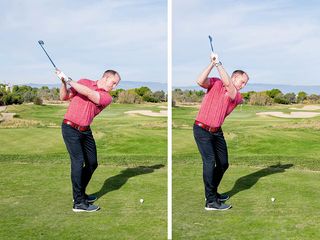With so many aspects of the golf swing to consider when trying to make improvements, it can feel overwhelming without the right expert golf tips. Understanding your swing plane is just one of those fundamental strands, as it could lead to better ball striking.
In this article, Golf Monthly Top 50 Coach John Howells shares everything you need to know about your golf swing plane…
Understanding Your Golf Swing Plane
To create a simple picture, I’m going to focus on lead-arm position at the top of the backswing. We could have a flat lead arm or one-plane swing (left image – below), more like Matt Kuchar, or we could have a more upright lead arm or two-plane swing (right image – below), like Bubba Watson.
If the lead arm is level with or below the shoulder plane, that would be a one-plane swing. The opposite is the lead arm getting above the shoulders on a more upright backswing plane.
One-plane swing (left) and two-plane swing (right) demonstrated by Golf Monthly Top 50 Coach John Howells
(Image credit: Tom Miles)
So, how does this play out in the downswing? The one-plane, flat backswing will require a really good rotation of the lower body and chest in the downswing. The club is probably going to exit a bit flatter on the way through and the clubface will look very stable post-impact.
With the two-plane swing, there’s a degree of hip slide towards the target and the clubface will be a lot more open coming down, so you’ll need more face rotation through impact.

(Image credit: Tom Miles)
Ask yourself, do you currently swing too much from the inside and hit draws and hooks? If so, maybe try the feeling of a more upright lead-arm position at the top.
Or, if you currently swing too much from the outside in the downswing and hit fades and slices, maybe try to feel a bit more of a flat lead arm at the top to get the club more on plane. A neutral swing plane, which allows a nice even blend of lateral and rotational movement of the pelvis in the downswing, is a third option that some golfers find to yield consistent results.
..
Click Here to Read the Full Original Article at Golf Monthly…
